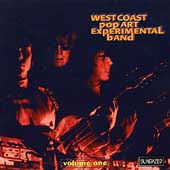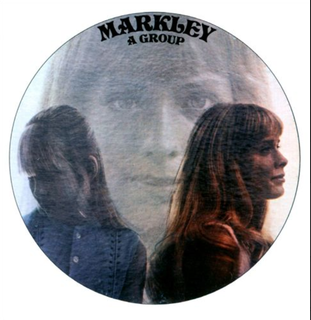
The Electric Prunes are an American psychedelic rock band, formed in Los Angeles, California, in 1965. Much of the band's music was, as music historian Richie Unterberger described it, possessed of "an eerie and sometimes anguished ambiance." Their most successful material was by songwriters Annette Tucker and Nancie Mantz, though the group also penned their own songs. Incorporating psychedelia and elements of embryonic electronic rock, the band's sound was marked by innovative recording techniques with fuzz-toned guitars and oscillating sound effects. In addition, guitarist Ken Williams' and singer James Lowe's concept of "free-form garage music" provided the band with a richer sonic palette and exploratory lyrical structure than many of their contemporaries.

Live/Dead is the first official live album released by the rock band Grateful Dead. Recorded over a series of concerts in early 1969 and released later the same year, it was the first live rock album to use 16-track recording.

The Olivia Tremor Control is an American psychedelic band from Athens, Georgia. The band's main line-up consists of Will Cullen Hart, Bill Doss, Eric Harris, John Fernandes, and Peter Erchick. The Olivia Tremor Control's music combines indie rock and neo-psychedelia, taking influence from psychedelic pop bands of the 1960s, such as the Beach Boys and the Beatles.

The Chocolate Watchband is an American garage rock band that formed in 1965 in Los Altos, California. The band went through several lineup changes during its existence. Combining psychedelic and garage rock components, their sound was marked by David Aguilar's lead vocals, songwriting, as well as proto-punk musical arrangements. The band's rebellious musical posture made them one of the harder-edged groups of the period with many critics labeling them as America's answer to the Rolling Stones.

The West Coast Pop Art Experimental Band (WCPAEB) was an American psychedelic rock band formed in Los Angeles, California, in 1965. The group created music that possessed an eerie, and at times sinister atmosphere, and contained material that was bluntly political, childlike, and bizarre. Representing different musical backgrounds among band members, the group, at times, resembled a traditional Byrds-esque folk rock ensemble, but the WCPAEB also, within the same body of work, recorded avant-garde music marked by multi-layered vocal harmonies.

Happy Hour is the fifth studio album by experimental music band King Missile, and released on December 15, 1992, by Atlantic Records. The album is exactly one hour long, hence its title.

East-West is the second album by the American blues rock band the Butterfield Blues Band, released in 1966 on the Elektra label. It peaked at #65 on the Billboard pop albums chart, and is regarded as highly influential by rock and blues music historians.

Get Closer is the eleventh studio album by singer Linda Ronstadt, released in 1982.

Volume 3: A Child's Guide to Good and Evil is the fourth album by the American psychedelic rock band The West Coast Pop Art Experimental Band (WCPAEB), and was released on Reprise Records in May 1968. By the time the group commenced recording Volume 3, guitarist Danny Harris had excused himself from the WCPAEB, reducing their numbers to a trio. As with the WCPAEB's earlier work, the album saw the band continue to blend psychedelic influences and complex studio techniques, and was marked by a bizarre fusion of innocence and malice in the band's lyrics. Volume 3 featured the WCPAEB's most ambitious music to date, and the striking cover art of John Van Hamersveld, yet it failed to sell in sufficient copies to chart nationally. In more recent times, the album has been considered the band's most accomplished work and a masterpiece of the psychedelic genre.

Volume One is the first album recorded by the psychedelic rock band the West Coast Pop Art Experimental Band. It was first released in 1966 on the small FiFo Records label. It was reissued in both compact disc and vinyl in 1997 by Sundazed. The album features covers of pop classics such as Richard Berry's "Louie, Louie" and the Kinks' "You Really Got Me". The songs mellow out into a blues/folk style with covers of Bob Dylan songs.

The Letter/Neon Rainbow is the debut album by American rock band the Box Tops, released in 1967. Following "The Letter" reaching number one on the singles charts, The Letter/Neon Rainbow was quickly assembled for a follow-up. The album peaked at number 87 on the Billboard Pop Albums chart in 1968.

John B. Sebastian is the debut album by American singer-songwriter John Sebastian, previously best known as the co-founder and primary singer-songwriter of the 1960s folk-rock band the Lovin' Spoonful. The album, released in January 1970, includes several songs that would become staples of Sebastian's live performances during the early and mid-1970s. Most notably, the album included "She's a Lady", Sebastian's first solo single, and an alternate version of "I Had a Dream" which was used to open the soundtrack album of the 1970 documentary film Woodstock. John B. Sebastian also featured support performances by David Crosby, Stephen Stills and Graham Nash several months before that trio agreed to work together as a performing unit.

Preflyte is a compilation album by the American folk rock band the Byrds and was released in July 1969 on Together Records. The album is a collection of demos recorded by the Byrds at World Pacific Studios in Los Angeles during late 1964, before the band had signed to Columbia Records and become famous. It includes early demo versions of the songs "Here Without You", "You Won't Have to Cry", "I Knew I'd Want You", and "Mr. Tambourine Man", all of which appeared in re-recorded form on the band's 1965 debut album.

Volume 2 (Breaking Through) is the third album by the American psychedelic rock group, the West Coast Pop Art Experimental Band, and was released in October 1967 on Reprise Records (R 6270 mono, RS 6270 stereo). At the time of recording, Michael Lloyd was not present so the group was reduced to Bob Markley and the Harris brothers, with additional uncredited contributions from Ron Morgan. On the back of original LP release appears 'Breaking Through' and the declaration: "Every song in this album has been written, arranged, sung and played by the group. No one censored us. We got to say everything we wanted to say, in the way we wanted to say it".

Where's My Daddy? is the fifth album by the American psychedelic rock group, the West Coast Pop Art Experimental Band, and was released in 1969 on Amos Records, which was owned by Jimmy Bowen. Amos Records signed them after Reprise Records dropped the band from their label following the commercial failure of their first three albums. It features compositions by Danny Harris, Michael Lloyd and Shaun Harris with lyrics by Bob Markley. On the original pressing, Lloyd's contributions were not noted on the back cover as a type of punishment by Markley for recent disagreements with each other. However, promotional copies do show Michael Lloyd's contributions noted on the back cover.

Markley, A Group is the sixth and final album by the American psychedelic rock group, the West Coast Pop Art Experimental Band, and was released in 1970 on Forward Records, owned by Mike Curb. In this case, the album was released under another group name, Markley A Group, as decided by the group owner, Bob Markley. It features compositions by Danny Harris, Michael Lloyd and Shaun Harris with lyrics by Bob Markley. The content is simple and soft, reminiscent of the band's earlier work. Lyrically, however, the band was continuing the trend set by Where's My Daddy?, in which they describe class resentment, paranoid psychedelia, and an unsettling interest in young girls. Although Shaun Harris creates compositions for the album, he only appears on "Outside/Inside". After this album, like those before it, failed to achieve success, the band ceased to exist.

Robert H. Markley was an American singer-songwriter and record producer who co-founded the psychedelic rock band The West Coast Pop Art Experimental Band, in the late 1960s, and became one of the most controversial figures that emerged from the era.
Michael Jeffrey Lloyd is an American record producer, arranger, songwriter and musician. After working with Mike Curb, Kim Fowley and others in the mid-to-late 1960s on musical projects including the West Coast Pop Art Experimental Band, and Steven Spielberg's first short film, Amblin', he became a producer of such teen idol pop stars as the Osmonds, Shaun Cassidy and Leif Garrett in the 1970s.

"Smell of Incense" is a song by the American psychedelic rock band the West Coast Pop Art Experimental Band, written by Ron Morgan and Bob Markley, and was released as a single on Reprise Records in 1968.
John A. Ware is an American drummer and percussionist known primarily for his session and live performance work.


















